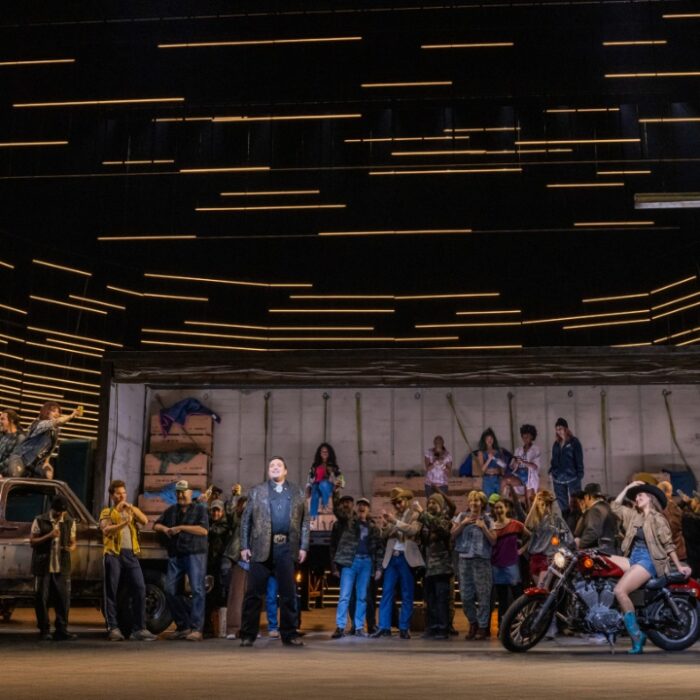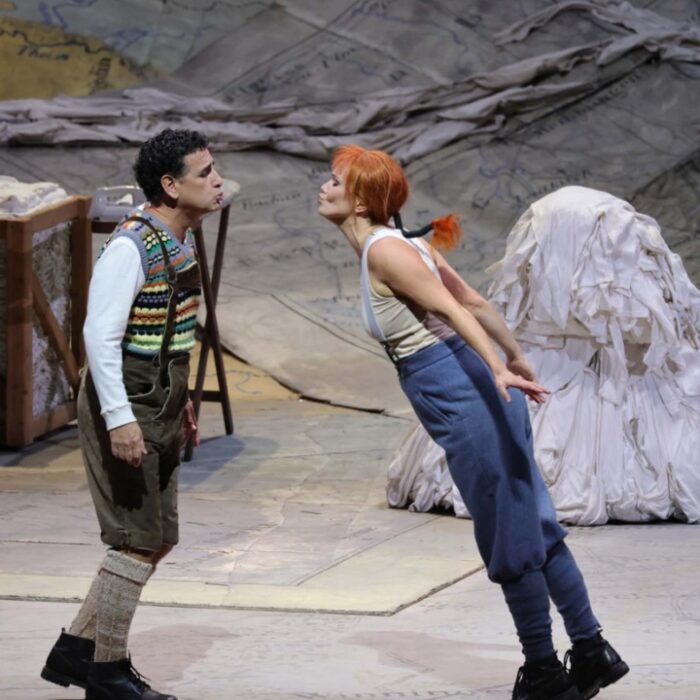
Opera Australia 2025 Review: Rusalka
By Zoltan Szabo(© Carlita Sari)
Of Antonín Dvořák’s ten operas, “Rusalka,” written around the dawn of the twentieth century and only a few years before the composer’s death, became his most successful. That this highly romantic fairytale (or should one say, water nymph tale?) should be the most courageous of Opera Australia’s (OA) offerings for the second half of this year, tells volumes about this company’s current difficulties, punctuated by the recent resignation of two of its senior executives, and a massive loss posted in its last annual report. Surrounded by a trifecta of operatic evergreens (“The Marriage of Figaro,” “La Bohème” and a brilliant new production of “Carmen”), box office success was still not assured, as the total performances of these four operas is still significantly lower than the combined number of performances of a new initiative, called Great Opera Hits (accompanied solely by piano, thus no orchestral expense) and countless renderings of the musical, “Rent.”
Production Details
Dvořák’s operas are imbued with bucolic melodies, a richness of orchestration and rustic rhythmic patterns, all characteristically Slavic, with roots founded on German operatic traditions. An unmistakeable nod to the opening of Wagner’s “Das Rheingold” is hard to miss right at the beginning of this opera, with the tree sprites’ coquettish underwater teasing of the Water King being a nearly verbatim copy of the scene between the Rheinmaidens and Alberich, composed nearly five decades earlier. (The parallel is further, if unintentionally, emphasized by the fact that Warwick Fyfe, singing the Water King here, performed the role of Alberich memorably in several past Australian “Rheingold” productions.)
As always, with Dvořák’s music, the success of the performance can be measured by the playing of the orchestra. Stage and orchestra is held together sympathetically by Johannes Fritzsch. He is continually attentive to details and the relatively rare, tender moments of the opera are wonderfully played. However, in the climactic sections, perhaps as an effort not to cover the singers, many of Dvořák’s surprising accents, sudden dynamic shifts and thus the dramatic sparkles of this characteristically Slavic music became tame or even lost under his direction.
The artistic responsibility of a modern “Rusalka” production is twofold: on the one hand, it needs to deliver high-quality cultural entertainment and justify its choice of the repertoire, on the other hand, while presenting works of past eras, it needs to promote 21st-century, thought-provoking opera performances that challenge current audiences.
Visually, many elements of this new production – most noticeably the openings of all three acts – are stunning. The combined artistry of Charles Davis (Set Designer), Renée Mulder (Costume Designer), Paul Jackson (Lighting Designer) and David Bergman (Video Designer), offers the multiple layers of the story innovatively, occupying the stage on several levels and in various ways. The opera begins with a tableau of the Waterworld, with bald-headed water nymphs doubled in number by a vertical mirror behind them, amongst the shells on the bottom of the lake, with water lilies above them. (While these lilies play the role of a horizontal divide between the worlds of the humans and the nymphs here, they become a vertical backdrop, as if showing an aerial view of the lake, in Act three to Rusalka’s agonizing netherworld.) The mirror is an excellent idea to optically extend the size of the diminutive stage. Unfortunately, at least twice on opening night, its angle was not quite correctly set and it exposed the warm orange glow of the conductor’s stand reflected among the cool blue-and-green hues of the water.
In contrast to the Waterworld, Act two begins in the Prince’s castle, with notable emphasis on human activities, such as the roasting of a pig. Party guests move around in elegant dresses, ladies in shades of coral, gentlemen in dinner suits; however, all appear in masks with bald tops (if there is a deeper meaning in both the human guests and Act one’s water spirits being equally hair-less, it escaped me), looking alienating as an “out-of-water” experience (pun intended) to the hapless Rusalka, stumbling to meet the Prince of her dreams. Here and elsewhere, director, Sarah Giles, refreshingly mixes elements of humour with a mostly sordid storyline, nowhere more so than at the party, where the jealous Rusalka tries to copy the pompous Duchess’s mannerisms.
Giles’s 2022 production of “Traviata” for OA was a convincing testimony to her superb sense of dramaturgy, timing and theatrical production. Here, however, she is working with a much thinner story than Victor Hugo’s “The Lady of the Camellias” which inspired Verdi’s opera and this results, for example, in every appearance of the Water King (Warwick Fyfe, as always, in excellent vocal shape) looking menacing but awkward, as his movements are minimal and seem undirected.
Jaroslav Kvapil’s libretto makes the water nymph protagonist mute (even if by magic…) for most of the central act, which seems counterintuitive and an oxymoron for a romantic opera. But to make the same protagonist stand for the whole final act on a narrow pedestal, her balance helped merely by an odd, pyramid-shaped transparent mount behind her, with extremely reduced possibilities for acting, made little theatrical sense and overemphasized the fundamentally static nature of this production.
Elsewhere, the layers of presentation were attractive and far more subtle; for example, projecting the image of the swimming Prince above the water sprites in Act one’s Waterworld, as if followed by an underwater camera, or the movements of the three tree sprites (Fiona Jopson, Jennifer Bonner and Helen Sherman acting and singing in great ensemble) wearing long branches instead of arms, was equally excellent.
Cast Highlights
Ashlyn Tymms in an ever-glittering costume performed all the magic as Ježibaba, the witch, with her great stage presence, reliable singing and she even managed to “pull out” Rusalka’s voice from her mouth in a long coil. Why she would need a shopping trolley for any of this, was difficult to understand, particularly as OA’s recent “Candide” production already experimented, also with limited success, with the introduction of a shopping trolley on stage.
The human roles were also presented with beautiful voices and emphatic singing. The scene opening Act two between Andrew Moran as the Gamekeeper and his Kitchen-Boy, Sian Sharp, was more vocally pleasing than dramatically relevant. Sharp’s all-too-brief appearance in the final act served as testimony to her refined musicality. Natalie Aroyan brought colour to the role of the Duchess with her powerful voice, an arrogantly selfish attitude and attractive stage presence – this perhaps helps to explain why Gerard Schneider’s handsome Prince fell so easily for her. Schneider’s voice is warm and appealing but became as wavering and weak facing vocal difficulties as his character was facing his moral troubles. A tenor next to Nicole Car’s unerring voice needs to be robust and compellingly seductive and Schneider’s portrayal is yet to achieve that level.
After stellar European appearances, Nicole Car is back to Australia. Her Rusalka kept making tragedy-prone decisions as the eponymous water nymph but was fully convincing both by the sheer beauty and maturity of her voice. She could be radiant and then her soprano soared, while the opera’s most famous aria, “Song to the Moon” (Měsíčku na nebi hlubokém), was so introverted and subtle that she sang much of it with her back to the audience. Her final scene with her Prince provided the opera’s most satisfying minutes (with another musical reference, this time rhyming with Wagner’s “Liebestod”), where Dvořák’s gentle lines cathartically beckoned the ultimate kiss and inevitable love-death.



